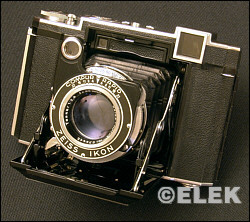Zeiss Ikon Super Ikonta 532/16

|
|
|
| Style, film format | Folding 6x6 rangefinder, 120 roll film |
|
|
|
| Lens, shutter | Coated f/2.8 80mm Tessar, Compur Rapid shutter |
|
|
|
| Photo quality | Excellent |
|
|
|
| Ergonomics | Very good for a large camera |
|
|
|
The Zeiss Ikon Super Ikonta B began life in the 1930s, offering some advanced features in a fairly compact, although hefty, package.
The 530/16 was one of three Super Ikontas to arrive in a short span. There were the so-called A, B, C and D models. The first three used 120 roll film, while the D model used 116. The A was a 6cm x4.5cm camera, while the B was 6x6 and the C was 6x9. The D model was even larger at 8x11.5.
The Super Ikonta B's novel feature, for a folding camera, was its ability to autospace the frames. For a roll film camera in the 1930s, this was a very noteworthy feature. The photographer had only to line up the first shot, and the camera's film advance mechanism took care of the rest, positioning each frame automatically. That made the camera a bit quicker to use, especially in fading light where it sometimes is very difficult to see the number through the red window (personal experience). The photographer had to give up one frame, so each roll yielded 11 shots, rather than 12.
The original Super Ikonta B featured a fast, uncoated f/2.8 Tessar mated to a Compur shutter. There were separate windows for focusing and composing, and like its other Super Ikonta siblings, the camera used the new Zeiss Ikon rotating wedge-prism to achieve correct focus.
The photographer could cradle the lens door in the palm of the left hand while using his or her thumb to focus the camera. Once in focus, the photographer had to merely shift their eye to the other eyepiece and snap the photo.
The 532/16 unified the rangefinder and viewfinder into one window, and the post-World War II camera featured a coated lens -- a nice improvement on an otherwise fine optic.
Like most cameras, the shutter had to be tensioned separately, and if the top speed was going to be used, the shutter speed dial had to be moved before the shutter was tensioned. A large dial at the base of the shutter sets the aperture. It's a very nice touch.
Folded, the camera is slightly thicker and somewhat taller than a 120 film spool. However, the prolific use of metal throughout resulted in a sturdy, heavy camera.
In use, the Tessar performs as expected. Wide open, it's slightly soft in the corners. Some people feel that Carl Zeiss pushed the Tessar lens design a bit too far at f/2.8. The sweet spot of the Tessar is from f/8-f/16, and this camera bears this out.
The weight of the camera works to its advantage, providing a stable shooting platform with few surprises. The Super Ikonta B has a right-handed shutter release, right-handed film advance and left-handed focusing, making it very easy to use and hold, particularly if you're used to modern-day SLRs.
